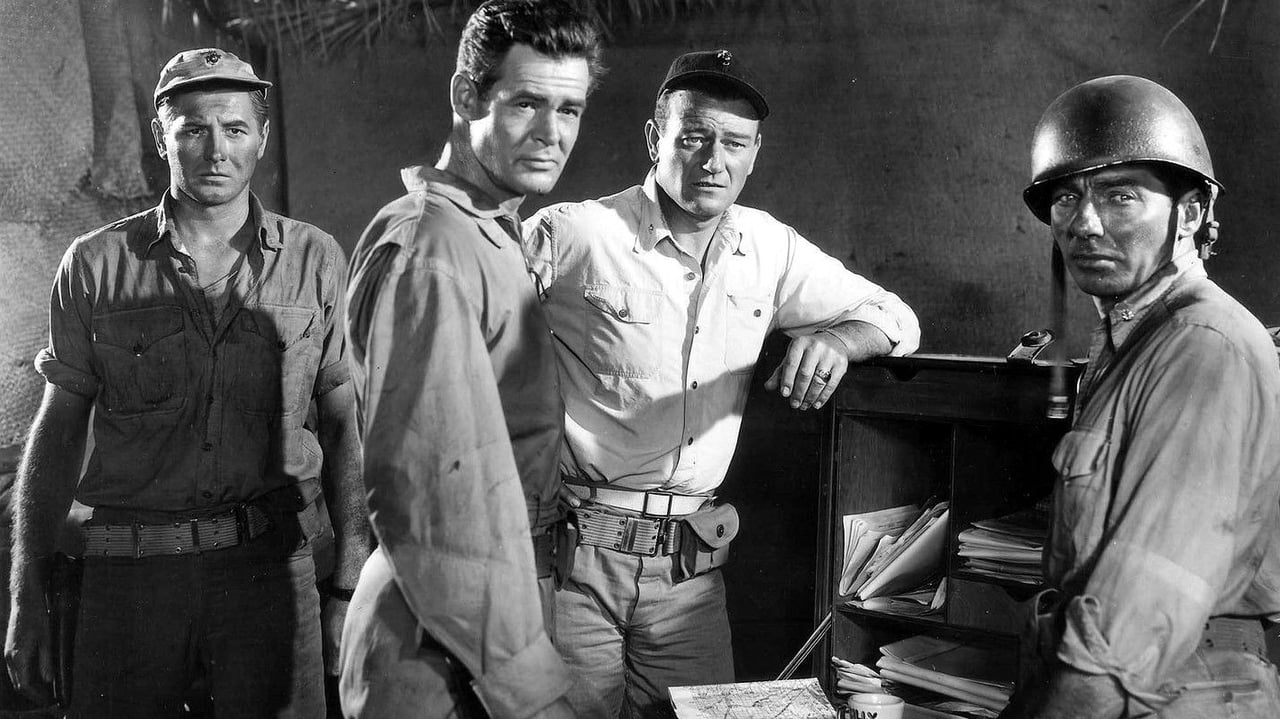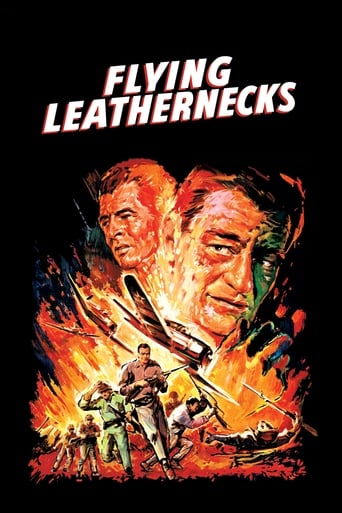

I don't believe I've ever seen so much stock footage interspersed with movie action before, used rather extensively here to provide an added sense of realism to the horrors of war. Some of it rather graphic too as related to men wounded and bleeding while being hauled off the battlefield.In the story, Major Daniel Kirby (John Wayne) is brought in to command the VMF 247 Wildcats stationed in Oahu, a Marine fighter squadron that presumably would have gone to Captain Carl Griffin (Robert Ryan), who for reasons that are revealed later, was passed over for promotion when the former commander was killed in action. Kirby has a battle theory of providing close air support for combat ground troops, an idea not embraced by the top brass because of the potential for friendly fire casualties.Interestingly, most of the tension in the story takes place between Kirby and Griff, who's questioning attitude of the commander's leadership calls upon the viewer to evaluate one's own feelings about the need to follow orders explicitly. Kirby's life and death battle decisions are made on the basis of achieving a greater good rather than attending to the needs of the individual, a concept that gets played out in combat situations a number of times in the story. The idea predictably comes full circle in the latter part of the picture when Griffin is faced with a difficult decision during an air battle that involves his own brother in law."Flying Leathernecks" is pretty much what you'd call a standard John Wayne vehicle in which he kicks a.. and takes names, best described by Robert Ryan's character when he admonishes his superior officer for not winning any friends among the men under his command, but certainly influencing them whether for good or ill. It's the same kind of hard boiled excess Wayne brought to other war films he appeared in, notably 1942's "Flying Tigers" and 1949's "Sands of Iwo Jima".
... View Morei thought this was a fairly decent war picture.it's not what i would call a classic,but it passes the time.the action sequences are pretty good,sometimes exciting.there's some obvious stock war scene footage mixed in with the film scenes.the acting is decent enough but not stellar,by any means,with maybe a bit of overacting going on possibly intentional.there's a bit of lite comedy thrown in that works well.the movie definitely has a pro war slant to it,so if that's not your thing,you may want to avoid it.otherwise,i'd say the movie is worth a watch on a lazy day when you have nothing better to do.for me,Flying Leathernecks is a 6/10
... View MoreAny tension FLYING LEATHERNECKS has as a war film from the '40s about the fight against the Japanese on Guadalcanal is bolstered considerably by the decent acting jobs done by JOHN WAYNE and ROBERT RYAN as men who are soon in conflict with each other over training methods. Wayne has his usual tough guy role, hard on the surface but soft inside, and Ryan is the man who stands up to him but soon appreciates him when the going gets rough.Whatever inaccuracies there are in historical details (as pointed out by other reviewers) don't really harm the story which is well photographed in Technicolor and includes a number of hard-hitting action scenes that are the best moments in the film. The domestic moments are the weakest elements of the story.Wayne and Ryan are well supported by JANIS CARTER (as Wayne's worried wife) and DON TAYLOR as a carefree soldier. Well directed by Nicholas Ray, it's not as tense and exciting as it could have been but it passes the time efficiently in its own way with lots of actual war footage appearing in the action scenes.
... View MoreMajor Dan Kirby {John Wayne} is a tough no nonsense leader, he takes control of his new unit, the Wildcats Squadron, and from the outset they find him overly harsh. They were hoping that the more amiable Captain Carl Griffin {Robert Ryan} was to lead them, and as the war rages both Kirby & Griffin find themselves at odds with each other, but as the battle of Guadalcanal looms, this unit must come together or face the consequences.The Flying Leathernecks has its problems for sure, the production is poor and the inter cutting of real footage is overkilled to the maximum. However the acting is very good and its tale of men under pressure trying to do the right thing is highly engrossing. The aerial sequences have the desired effect, and the horrors of war are fully realised, but ultimately what makes The Flying Leathernecks a worthy picture is the portrayal of the two lead characters by Wayne & Ryan, how the two men do what it takes to give their squadron the best chance of surviving, both Wayne & Ryan shine and put much gravitas to the picture. As a character study it isn't as good as something like Twelve O'Clock High, but it's a very involving picture that deserves to be considered a worthwhile entry to the sub-genre of psychological war films. 7/10
... View More